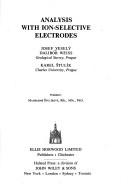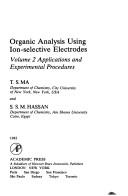| Listing 1 - 10 of 12 | << page >> |
Sort by
|
Book
Year: 2002 Publisher: Adelphi, MD : U.S. Army Research Laboratory,
Abstract | Keywords | Export | Availability | Bookmark
 Loading...
Loading...Choose an application
- Reference Manager
- EndNote
- RefWorks (Direct export to RefWorks)
Copper-tin alloys. --- Anodes. --- Lithium cells.
Book
Year: 2012 Publisher: Adelphi, MD : Army Research Laboratory,
Abstract | Keywords | Export | Availability | Bookmark
 Loading...
Loading...Choose an application
- Reference Manager
- EndNote
- RefWorks (Direct export to RefWorks)
Microbial fuel cells. --- Biofilms. --- Anodes. --- Alginates. --- Catalysts.
Book
Year: 1985 Publisher: Washington, D.C. : National Aeronautics and Space Administration, Scientific and Technical Information Branch,
Abstract | Keywords | Export | Availability | Bookmark
 Loading...
Loading...Choose an application
- Reference Manager
- EndNote
- RefWorks (Direct export to RefWorks)
Traveling-wave tubes --- Anodes --- Testing. --- Design and construction.
Book
ISBN: 0323851819 0128196602 9780323851817 9780128196601 Year: 2021 Publisher: Cambridge, MA : Elsevier,
Abstract | Keywords | Export | Availability | Bookmark
 Loading...
Loading...Choose an application
- Reference Manager
- EndNote
- RefWorks (Direct export to RefWorks)
Anodes. --- Silicon --- Lithium ion batteries --- Electric properties. --- Materials. --- Cells, Lithium ion --- Electrochemical cells, Lithium ion --- LIBs (Lithium ion batteries) --- Li-ion batteries --- Lithium ion cells --- Lithium ion electrochemical cells --- Storage batteries --- Electrodes
Book
ISBN: 0471995347 9780471995340 Year: 1978 Publisher: New York: Wiley,
Abstract | Keywords | Export | Availability | Bookmark
 Loading...
Loading...Choose an application
- Reference Manager
- EndNote
- RefWorks (Direct export to RefWorks)
fysicochemie --- Electrochemistry --- Electrodes --- Electrochimie --- Tables --- Electrodes. --- Electrochemistry. --- 541.134 <083> --- #ABIB:adid --- elektrode --- Electrochemistries --- Anode --- Cathode --- Anodes --- Cathodes --- Electrode --- Electromotive force. Potential series--Tabellen. Lijsten. Indices --(niet-bibliografische) --- Tables. --- 541.134 <083> Electromotive force. Potential series--Tabellen. Lijsten. Indices --(niet-bibliografische) --- Electric resistors --- Chemistry, Physical and theoretical --- Anode Materials --- Cathode Materials --- Anode Material --- Cathode Material --- Material, Anode --- Material, Cathode --- Electrodes - Tables --- Electrochemistry - Tables --- Electric potential

ISBN: 0853120927 0470262966 9780853120926 Year: 1978 Publisher: Chichester : Ellis Horwood,
Abstract | Keywords | Export | Availability | Bookmark
 Loading...
Loading...Choose an application
- Reference Manager
- EndNote
- RefWorks (Direct export to RefWorks)
Ion Exchange. --- Electrodes. --- Electrochemistry. --- 541.135.5 --- 543.25 --- Electrochemistries --- Anode --- Cathode --- Anodes --- Cathodes --- Electrode --- Exchange, Ion --- Electrodes and diaphragms, e.g. --- Electroanalysis. Electrolytic methods. Electrometric methods --- Analytische toepassingen --- Ionselectieve elektroden --- Analytische toepassingen. --- Ionselectieve elektroden. --- 543.25 Electroanalysis. Electrolytic methods. Electrometric methods --- 541.135.5 Electrodes and diaphragms, e.g. --- Ion Exchange --- Electrodes --- Electrochemistry --- Electrodes and diaphragms, e.g --- Anode Materials --- Cathode Materials --- Anode Material --- Cathode Material --- Material, Anode --- Material, Cathode --- Electrochemical analysis --- Electrodes, ion selective

ISBN: 0124629024 Year: 1982 Publisher: London : Academic Press,
Abstract | Keywords | Export | Availability | Bookmark
 Loading...
Loading...Choose an application
- Reference Manager
- EndNote
- RefWorks (Direct export to RefWorks)
Chimie analytique --- Analytical chemistry --- Électrode --- Electrodes --- Technique analytique --- Analytical methods --- methods --- Chemistry Techniques, Analytical --- Chemistry, Organic --- Electrochemistry. --- Electrodes. --- Ion Exchange. --- 541.135.5 --- 543.25 --- 543.8 --- Exchange, Ion --- Anode --- Cathode --- Anodes --- Cathodes --- Electrode --- Electrochemistries --- methods. --- Electrodes and diaphragms, e.g. --- Electroanalysis. Electrolytic methods. Electrometric methods --- Analysis of organic substances --- 543.8 Analysis of organic substances --- 543.25 Electroanalysis. Electrolytic methods. Electrometric methods --- 541.135.5 Electrodes and diaphragms, e.g. --- Anode Materials --- Cathode Materials --- Anode Material --- Cathode Material --- Material, Anode --- Material, Cathode --- Electrochemistry --- Ion Exchange --- Chimie organique --- Ion-selective electrode
Book
Year: 2022 Publisher: Basel MDPI - Multidisciplinary Digital Publishing Institute
Abstract | Keywords | Export | Availability | Bookmark
 Loading...
Loading...Choose an application
- Reference Manager
- EndNote
- RefWorks (Direct export to RefWorks)
The conversion and storage of renewable energy sources is key to the transition from a fossil-fuel-based economy to a low-carbon society. Many new game-changing materials have already impacted our lives and contributed to a reduction in carbon dioxide emissions, such as high-efficiency photovoltaic cells, blue light-emitting diodes, and cathodes for Li-ion batteries. However, new breakthroughs in materials science and technology are required to boost the clean energy transition. All success stories in materials science are built upon a tailored control of the interconnected processes that take place at the nanoscale, such as charge excitation, charge transport and recombination, ionic diffusion, intercalation, and the interfacial transfer of matter and charge. Nanostructured materials, thanks to their ultra-small building blocks and the high interface-to-volume ratio, offer a rich toolbox to scientists that aspire to improve the energy conversion efficiency or the power and energy density of a material. Furthermore, new phenomena arise in nanoparticles, such as surface plasmon resonance, superparamegntism, and exciton confinement. The ten articles published in this Special Issue showcase the different applications of nanomaterials in the field of energy storage and conversion, including electrodes for Li-ion batteries and beyond, photovoltaic materials, pyroelectric energy harvesting, and (photo)catalytic processes.
nanoparticle --- nanoalloy --- catalyst --- CO2 reduction --- hydrocarbon --- synthetic fuel --- iron --- cobalt --- perovskite solar cell --- hole transport layer --- CuCrO2 nanoparticles --- thermal stability --- light stability --- aluminum ion batteries --- reduced graphene oxide --- tin dioxide --- 3D electrode materials --- mechanical properties --- TiO2 --- azo dye --- wastewater treatment --- photocatalysis --- sodium formate --- dry etching --- black silicon --- photovoltaics --- plasmonics --- heterogeneous catalysis --- nanoparticles --- single molecule localization --- super-resolution microscopy --- surface-enhanced Raman spectroscopy --- Li-ion batteries --- anodes --- intermetallics --- silicon --- composites --- nanomaterials --- coating --- mechanochemistry --- zinc sulfide --- wurtzite --- co-precipitation synthesis --- solvent recycling --- green synthesis --- scaling up --- pilot plant --- chalcopyrite compounds --- nanocrystals --- hydrothermal --- spin coating --- EIS --- conductivity --- lithium-ion batteries --- SnO2 --- nanoarray --- anode --- high-rate --- n/a
Book
ISBN: 3036550224 3036550216 Year: 2022 Publisher: MDPI - Multidisciplinary Digital Publishing Institute
Abstract | Keywords | Export | Availability | Bookmark
 Loading...
Loading...Choose an application
- Reference Manager
- EndNote
- RefWorks (Direct export to RefWorks)
The start of high-volume production of field-effect transistors with a feature size below 100 nm at the end of the 20th century signaled the transition from microelectronics to nanoelectronics. Since then, downscaling in the semiconductor industry has continued until the recent development of sub-10 nm technologies. The new phenomena and issues as well as the technological challenges of the fabrication and manipulation at the nanoscale have spurred an intense theoretical and experimental research activity. New device structures, operating principles, materials, and measurement techniques have emerged, and new approaches to electronic transport and device modeling have become necessary. Examples are the introduction of vertical MOSFETs in addition to the planar ones to enable the multi-gate approach as well as the development of new tunneling, high-electron mobility, and single-electron devices. The search for new materials such as nanowires, nanotubes, and 2D materials for the transistor channel, dielectrics, and interconnects has been part of the process. New electronic devices, often consisting of nanoscale heterojunctions, have been developed for light emission, transmission, and detection in optoelectronic and photonic systems, as well for new chemical, biological, and environmental sensors. This Special Issue focuses on the design, fabrication, modeling, and demonstration of nanodevices for electronic, optoelectronic, and sensing applications.
Technology: general issues --- History of engineering & technology --- concentrator systems --- GaInP/GaInAs/Ge --- multi-junction --- photovoltaics --- solar cells --- space --- triple-junction --- FeFET --- ferroelectric --- nonvolatile --- semiconductor memory --- SBT --- nanoantennas --- optics --- optoelectronic devices --- photovoltaic technology --- rectennas --- resistive memories --- thermal model --- heat equation --- thermal conductivity --- circuit simulation --- compact modeling --- resistive switching --- nanodevices --- power conversion efficiency --- MXenes --- electrodes --- additives --- HTL/ETL --- design of experiments --- GFET --- graphene --- high-frequency --- RF devices --- tolerance analysis --- molybdenum oxides --- green synthesis --- biological chelator --- additional capacity --- anodes --- lithium-ion batteries --- carbon nanotube --- junctionless --- tunnel field effect transistors --- chemical doping --- electrostatic doping --- NEGF simulation --- band-to-band tunneling --- switching performance --- nanoscale --- phosphorene --- black phosphorus --- nanoribbon --- edge contact --- contact resistance --- quantum transport --- NEGF --- metallization --- broadening --- zigzag carbon nanotube --- armchair-edge graphene nanoribbon --- quantum simulation --- sub-10 nm --- phototransistors --- photosensitivity --- subthreshold swing --- GaN HEMTs --- scaling --- electron mobility --- scattering --- polarization charge --- 2D materials --- rhenium --- selenides --- ReSe2 --- field-effect transistor --- pressure --- negative photoconductivity --- n/a
Book
Year: 2022 Publisher: Basel MDPI - Multidisciplinary Digital Publishing Institute
Abstract | Keywords | Export | Availability | Bookmark
 Loading...
Loading...Choose an application
- Reference Manager
- EndNote
- RefWorks (Direct export to RefWorks)
This book describes recent studies in the development of nanomaterials for various secondary batteries, including Li-ion batteries (LIBs), Li–air batteries, and multivalent aqueous batteries. A simple, low-cost, and scalable synthetic process for the development of nanomaterials is another research topic in this book. The recent studies dedicated by researchers in this book highlight the importance of innovative nanostructures and new functional materials, which can open new opportunities for battery research.
SnO2 --- self-assembly --- MoS2 --- nanosheets --- lithium-ion battery --- inorganic filler --- gel polymer electrolytes --- TiO2 --- Al2O3 --- SiO2 --- ZrO2 --- CeO2 --- BaTiO3 --- lithium polymer batteries --- Ag --- nanoparticle --- high rate --- zinc metal anode --- copper coating --- alloy interfacial layer --- uniform Zn deposition --- aqueous zinc-ion battery --- Ce-doped LaMnO3 perovskite --- XPS of LaMnO3 --- bifunctional activity --- probe sonication --- carbon-based composite --- transition metal dichalcogenide --- aqueous multivalent metal-ion batteries --- zinc-ion batteries --- magnesium-ion batteries --- aluminum-ion batteries --- aqueous batteries --- electrochemistry --- electrode materials --- ammonium vanadate --- ZnO --- composites --- binary --- ternary --- LIBs --- anode --- Zn metal anode --- aqueous Zn ion batteries --- mildly acidic electrolyte --- dendrite-free --- hydrogen evolution reaction suppression --- InSb --- InSb–C --- PAA binder --- anodes --- Li-ion batteries --- WS2 --- W2C --- hydrothermal method --- carbon nanotubes --- lithium-ion batteries --- n/a --- InSb-C
| Listing 1 - 10 of 12 | << page >> |
Sort by
|

 Search
Search Feedback
Feedback About UniCat
About UniCat  Help
Help News
News